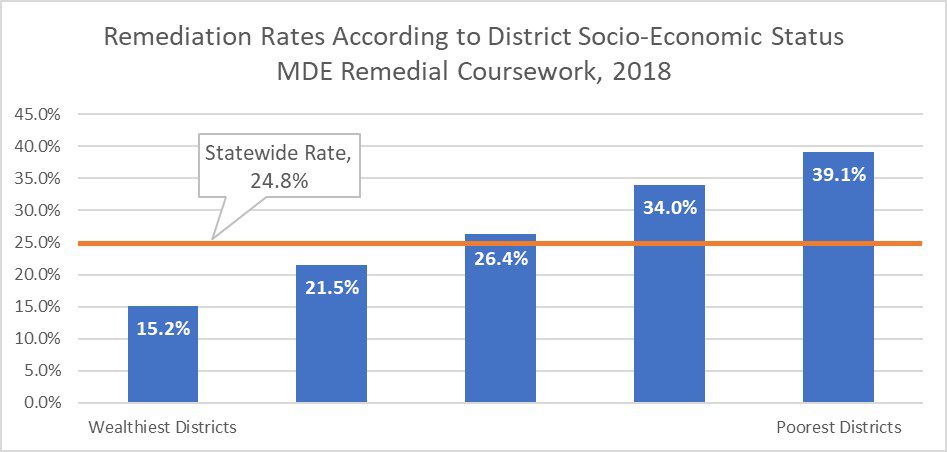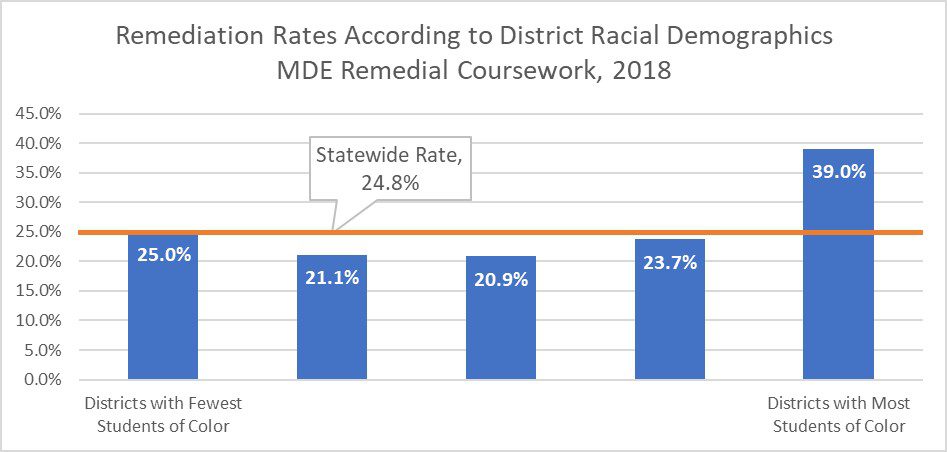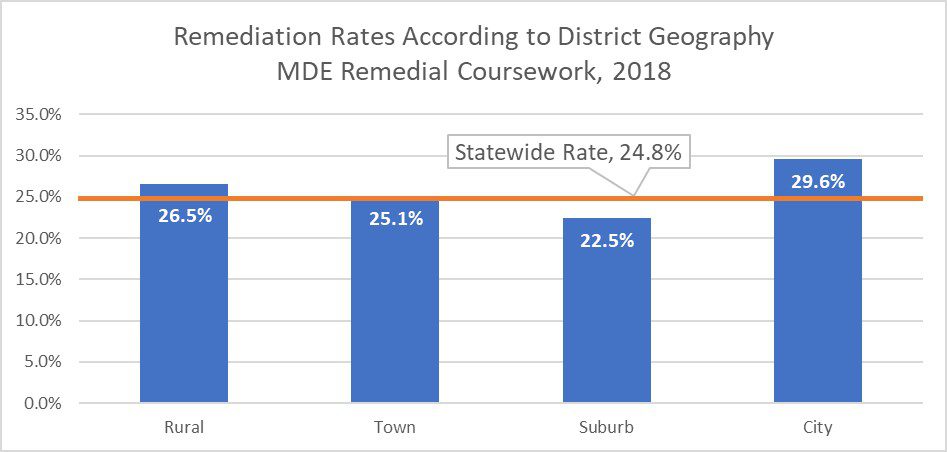Analysis: Michigan’s College Remediation Rates in Poor Districts More Than Double the Rate of Wealthier Districts
Without additional funding and supports, COVID-19 crisis may exacerbate troubling trends
This analysis is part of a periodic series examining the six recommendations in our recent 2020 State of Michigan Education Report, a Marshall Plan: Reimagining Michigan Public Education. This post explores the recommendation on transition to postsecondary opportunities.
By Riley Stone, data and policy analyst
Before the COVID-19 crisis, ensuring all Michigan students were college- and career-ready was already a challenge. For some high school students, especially those preparing to transition to postsecondary education, disruptions to learning due to the pandemic may be disproportionately harmful – and expensive.
A new analysis by The Education Trust-Midwest shows that vulnerable student groups, including students of color, students from low-income families and students in rural and urban districts, were more likely to be enrolled in college remediation classes – even before the pandemic caused abrupt school closures across the state.
The risk of exacerbating inequities is even greater due to the recent disruptions to learning. Therefore structural barriers, such as unequal access to quality virtual instruction or unequal enrollment in college remediation courses, are more likely to impact vulnerable student groups than ever before.
When students begin postsecondary degree programs without the necessary fundamental skills, they are often required to take – and thus pay for – remediation courses that will support them in building skills that should have been developed during K-12 education. Remedial courses are not credit-bearing, meaning they do not count toward a degree. This can result in additional costs for students, more time to complete a degree, and a higher likelihood of dropping out before graduation.
According to the most recent data, 24 percent of Michigan high school graduates that enrolled in one of Michigan’s two- or four-year postsecondary programs were required to take at least one remediation course during the 2017-18 academic year. This means nearly one in four Michigan students were paying for additional instruction in college due to Michigan’s troubled K-12 education system.
Remediation rates were even more startling for historically underserved subgroups, according to the analysis, which examined college remediation rates according to socioeconomic status, racial demographics, and geography.
For example, 43.9 percent of Michigan’s African American students who enrolled in Michigan postsecondary programs were required to take at least one remedial course.
The remediation rate for Michigan’s poorest districts was over two and a half times higher than the rate for the wealthiest districts – and more than 14 percentage points higher than the statewide rate.

In districts with the highest concentrations of students of color, nearly 4 in 10 students were enrolled in a college remediation course.

It is important to highlight that this is a shared problem across the state. Urban, town and rural districts’ remediation rates were above the statewide rate.

Michigan’s disheartening college remediation problem is not new. While remediation rates have slightly decreased since 2014, they have been on an upward trajectory overall since 2007.

In our recent 2020 State of Michigan Education Report, A Marshall Plan: Reimagining Michigan Public Education, we outline research-based strategies that state and districts leaders should consider to better prepare students for their transition to postsecondary opportunities.
To lower the need for remediation due to COVID-19, high school students will need an even stronger focus on college readiness. One option is to provide students with extended day learning, another is to provide college remedial coursework that’s ideally paid for by federal stimulus dollars to reduce the financial burden on students.
State leaders can also support graduating high school students by fully funding the cost of remedial education taken at a Michigan community college, for example. This would ensure that the significant cost of missing important coursework due to the rapid transition to distance learning in the 2019-20 school year or due to any future disruptions does not fall on the shoulders of graduating students.
Additionally, the state should ensure that high school students access needed supports without costs to the students or their families. A commendable first step by the Michigan Department of Education is that high school seniors who were not able to take the school-administered SAT as eleventh graders in spring 2020 will have the opportunity to do so when they return to school in the fall.
Additional supports around accessibility and affordability of postsecondary opportunities will also be needed, including protecting student access to financial aid, increasing efforts to support students in completing the Free Application for Federal Student Aid (FAFSA) and finding effective ways to inform and support students through the application and enrollment processes if distance learning must continue.
Remediation has been – and continues to be – an equity issue, putting the cost of a failed education system on the shoulders of Michigan’s students, especially the most vulnerable students.
While there is real risk in the COVID-19 pandemic of exacerbating this issue, there is also real opportunity to reimagine Michigan’s education system and provide extra supports to students transitioning to postsecondary education that endure beyond the current health crisis.
Together, we can build a more equitable education system that meets the needs of every learner, regardless of income, race or zip code.
Michael Arbit, data consultant, and Mary Grech, senior data and policy analyst, also contributed to the data analyses in this report.
Read more on College Readiness and view the technical appendix.
